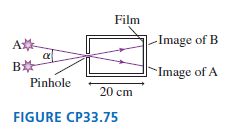The pinhole camera of FIGURE CP33.75 images distant objects by allowing only a narrow bundle of light
Question:
The pinhole camera of FIGURE CP33.75 images distant objects by allowing only a narrow bundle of light rays to pass through the hole and strike the film. If light consisted of particles, you could make the image sharper and sharper (at the expense of getting dimmer and dimmer) by making the aperture smaller and smaller. In practice, diffraction of light by the circular aperture limits the maximum sharpness that can be obtained. Consider two distant points of light, such as two distant streetlights. Each will produce a circular diffraction pattern on the film. The two images can just barely be resolved if the central maximum of one image falls on the first dark fringe of the other image.?

a. Optimum sharpness of one image occurs when the diameter of the central maximum equals the diameter of the pinhole.What is the optimum hole size for a pinhole camera in which the film is 20 cm behind the hole? Assume λ = 550 nm, an average value for visible light.b. For this hole size, what is the angle α (in degrees) between two distant sources that can barely be resolved?c. What is the distance between two street lights 1 km away that can barely be resolved?
Step by Step Answer:

Physics for Scientists and Engineers A Strategic Approach with Modern Physics
ISBN: 978-0133942651
4th edition
Authors: Randall D. Knight





